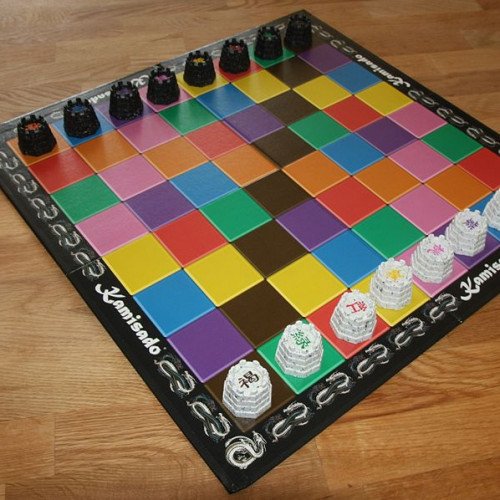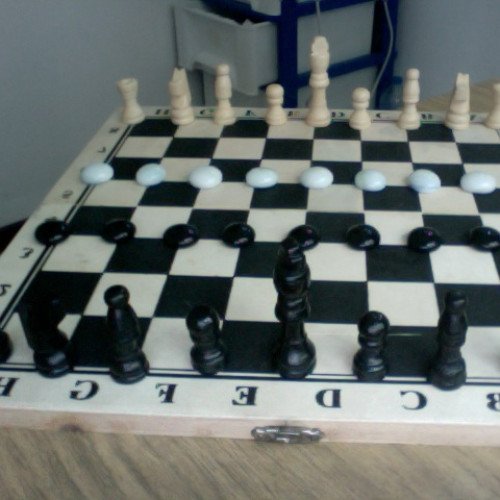KAMISADO VS OUK-KHMER

KAMISADO
Kamisado is an abstract strategy board game for two players that's played on an 8x8 multicoloured board. Each player controls a set of eight octagonal dragon tower pieces. Each player's set of dragon towers contains a tower to match each of the colours that appear on the squares of the board (i.e., a brown tower, a green tower, etc.). One player's towers have gold dragons mounted on the top, while the other player's towers are topped with black dragons. In an interview, designer Peter Burley said that the design of Kamisado dated back to a chance observation in a men's room in the 1970s. "I noticed that the floor had an interesting pattern of small colored tiles", he said. "I mentally made a note that this could possibly be used as a basis for a board game – this is something that I do quite a lot, whenever I see something a bit different. It must have made a deep impression on this occasion, however, because that night I had a vivid dream involving this tile pattern, and somehow the notion of 'whatever colour you land on, your opponent must move a piece that matches this'. I guess my subconscious mind had been working on this and sorted it out while I was asleep." The players’ towers start the game on the row nearest to them. The players take turns moving one tower any number of spaces in a straight line, either directly forwards or diagonally forwards, but not into or through a square already containing another dragon tower. The player with the black dragons moves first and may choose any tower. From this point onwards, each player must move the dragon tower that matches the colour of the square that the opponent's last move finished on. The object of the game is to reach your opponent's Home Row with one of your dragon towers. The first player to achieve this goal is the winner of the round. Games may be played as single rounds, or as more advanced ‘Match’ formats. Matches are played up to 3 points (Standard Match), 7 points (Long Match) or 15 points (Marathon Match). During a match, each time a round is won, a special ‘Sumo Ring’ is added to the dragon tower that has fought its way through to the opponent's Home Row. The sumo rings provide the scoring system for the game, and also endow special powers to the dragon towers that carry them. These towers are known as Sumo towers and have the ability to push opponent's towers back one space, by using a move known as a ‘Sumo Push’.
Statistics for this Xoptio

OUK-KHMER
Ouk-Khmer (also known as Cambodian Chess) is a chess variant which D. B. Pritchard claimed was played in Cambodia although its actual origins appear to be unknown. Pritchard gives the source as P. A. Hill. It combines elements of makruk and xiangqi. Similar to xiangqi, it is played on the intersections of an 8×8 monotone board (instead of 8×9). Contrary to Pritchard's claim, the actual variety of chess played in Cambodia today, known as "Ok" or "Ouk Chatrang", is nearly identical to makruk. The authenticity of the game described by Pritchard remains doubtful. Pritchard (The Encyclopedia of Chess Variants, 1994) described this game as "an old variant displaying elements of Burmese Chess, Chaturanga and Makruk". However, the rules provided appear to be a hybrid of Makruk and Xiangqi. For example, play on the intersections and the movement of the fish (pawn) follow Xiangqi rules. The advanced placement of the full line of pawns resembles the initial setup of makruk. The naming of the "boat" also follows makruk. John Gollon, the author of "Chess Variations: Ancient, Regional, and Modern", received a description of a chess game in 1969 from a U.S. serviceman who claimed to have obtained the details from a Cambodian born guerrilla officer he was questioning. The serviceman expressed concern that he may have been mistaken about some of the details and Gollon stated that he was never able to confirm the details with an official Cambodian source. He admitted in his letter: “The correspondent later expressed some concern that he may have been mistaken in some details.” In 2007, the English chess specialist John Beasley published a revised edition of late D.B.Pritchard's book (The Classified Encyclopedia of Chess Variants), in which more details from Gollon's letter were given (such as the local names of the chessmen, not included in the 1st edition) and where Beasley expressed his strong doubt about the authenticity of this kind of chess. In reaction to this publication, Beasley was sent information that a set of this chess had made an apparition in an exhibition in Tokyo in 2002 as well as in several Japanese books that preceded or followed, written by Umebayashi Isao and Okano Shin. They could have rediscovered these rules by translating a book bought in Cambodia, where the Elephant could not capture sideways. The names they gave for the chessmen were somewhat different from Gollon (Kwon, Neamahn, Kwo, Seh, Tuuk, Trey as for the table). Umebayashi and Okano designated that game as "shattrong". A photo of a complete set was available showing the 18 pieces on a board with marked diagonals. Beasley published a corrective note in the British specialized magazine Variant Chess (Issue 55, September 2007 and issue 64, August 2010 ) to acknowledge this second “evidence”. He acknowledged that the game is apparently absent "from the streets of Phnom Penh in 2003" and stated that Peter suggested "that this may have been a minor consequence of the mass killings of the Pol Pot era.". The situation has been cleared out in 2012 with the help of a Japanese chess researcher, Yasuji Shimuzu who got in touch with Umebayashi Isao. First, it has been now understood that Umebayashi and Okano's books were simply presenting a reconstruction of the “Cambodian” chess which they had discovered in Pritchard's first edition. As Pritchard didn't name the chessmen in his first edition, the Japanese authors extrapolated the names with the help of a dictionary. No Cambodian books had been consulted and even found. The difference in Elephant's move was simply a misreading. Finally, looking for an illustration, they just set up a set of makruk with additional Fishes and Officials over a facsimile Burmese board that they had and fitted well the size of his chessmen. John Beasley published a corrective note on his website http://www.jsbeasley.co.uk/. His conclusion is that the game described to P. A. Hill in 1969 appeared once more to reduce to a single informant whose statements were at variance with all other known testimony. Moreover, John Beasley has found and proven that the game is flawed if played seriously.